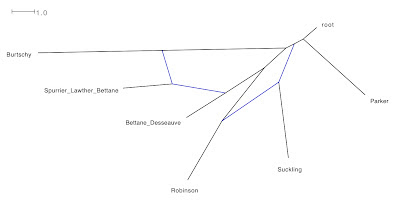The point of doing this is that the critics regularly claim that a particular year has produced "the vintage of the century", which they did for Bordeaux in 2000, 2005 and 2009. Leaving aside the obvious hyperbole, the 2005 vintage was a apparently a very different affair (Wine Spectator magazine gave it a score of 98/100) from the 2004 vintage (Wine Spectator score = 89). (Note that these scores can vary only from 50-100, not 0-100, so the scores are actually 96% versus 78%, respectively.) This means that we can compare a very good vintage with an ordinary one, to see if it makes any difference to the way the evaluators behave.
As last time, the data to be analyzed are taken from the bordOverview (Bolomey Wijnimport) website: http://www.bordoverview.com/?year=2005. They consist of quality ratings of 141 wines by 6 expert commentator groups (associated with wine magazines or newsletters), these scores being awarded in October 2008:
United States of America
Wine Advocate (Robert Parker)
Wine Spectator (James Suckling)
United Kingdom
Jancis Robinson
Decanter (Steven Spurrier, James Lawther, Michel Bettane)
France
Tast (Michel Bettane, Thierry Desseauve)
La Revue du Vin de France (Bernard Burtschy)
The scores have been converted to a 0-100 scale, and all wines were evaluated by all commentators. The manhattan distance measure was calculated between each pair of commentators, and the result displayed as a NeighborNet network. People who are closely connected in the network are similar to each other based on their scoring patterns, and those who are further apart are progressively more different from each other.
 |
| Click to enlarge. |
Note, first, that there is considerable conflict among the critics. As noted last time, they certainly don't agree with each other uniformly, presumably because wine tasting is an art not a science.
Second, the relationship between the commentators is quite different compared to last time. Importantly, this time there is no suggestion of a cultural divide between the French- and English-speaking commentators. Perhaps cultural preferences play a larger role only when the wine is of average quality (2004) whereas high-quality wine (2005) has more international appreciation.
Finally, there are more long terminal edges than last time, indicating that more of each opinion is unique to that particular commentator. This suggests that personal preferences play a larger role when evaluating good wine (2005) compared to average wine (2004). Apparently it is not true that "good wine is good wine and everyone can agree on it".
Once again, we can also produce a directed graph rather than an undirected one, by nominating Robert Parker as the outgroup to the others, and producing a rooted reticulation network. In this diagram the blue lines indicate "hybridization" histories.
 |
| Click to enlarge. |
In this analysis, the Decanter (Spurrier et alia) and Wine Spectator (Suckling) opinions are hybrid ones, as they also were last time. (The Revue du Vin de France opinion is not a hybrid this time.) However, only one of the hybrid sources is the same as last time (Parker's as a source of Suckling's). Interestingly, the Decanter opinion, from the UK, is simply a mixture of the two French opinions. The presence of Michel Bettane on two of the tasting panels may have something to do with this. Also, the Wine Spectator is a hybrid of UK and US opinions.
As before, everyone's opinion seems to be someone else's, modified in response to someone else again; and this is not related to whether the wine is "good" or "average" since it happened for both 2004 and 2005.

No comments:
Post a Comment